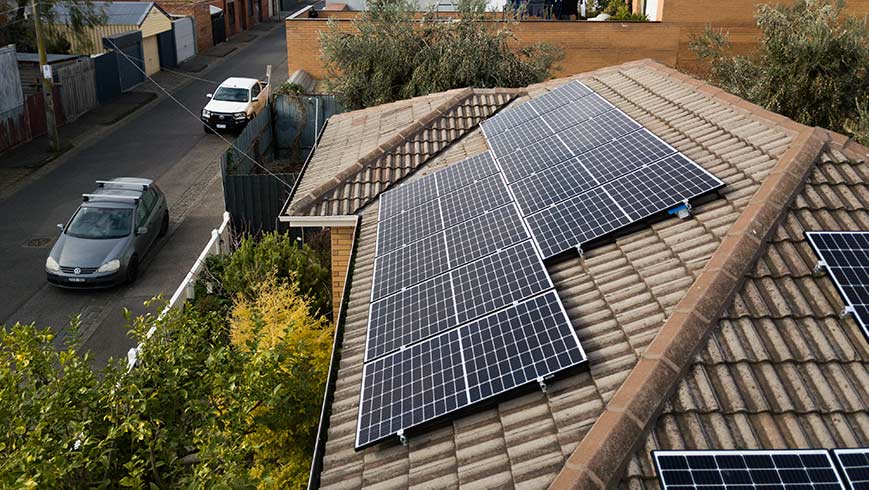

Image: Q Cells
High solar feed-in tariffs (FiTs) are increasingly being marketed as a means of slashing electricity bills, but consumers shouldn’t take the bait blindly.
Unless you have a battery coupled to your solar system, any electricity generated by your solar panels will be consumed by the household or fed into the electricity grid. Feed-in tariffs (FiT) are arrangements where owners of solar PV systems are paid for the electricity they generate to the grid. Essentially FiTs are an incentive for compensating that arrangement, but have also been used to subsidise and encourage the uptake of renewable energy.
Net FiTs pay consumers for the surplus energy that is fed back into the grid – and all FiTs in Australia operate on this type of scheme now.
Gross feed-in-tariffs, which pay for every kWh generated regardless of energy consumed, were offered for domestic solar installations until 2009. Solar FiTs used to be mandatory in every state, and offered highly generous rates to new applicants, which have since been closed to new applicants (more about historic FiTs on Solar Choice).
The amount of energy that each solar system can export to the grid can be capped by size limits set by network operators. The size limit is generally up to 5kW for single-phase connections (most home solar systems). Solar Choice explains that our electricity infrastructure wasn’t designed for a system with lots of distributed generation and bidirectional flow, which is the main reason networks put limits on solar system sizes. Systems greater than a certain size may not be approved to export energy to the grid, so the owners will not see any FiT benefit.
Rooftop solar is even more tightly regulated in South Australia since the state introduced new rules that require strict inverter standards and the nomination of an agent that can switch off household solar, if the market operator requires.
FiTs earned are paid for every kWh fed to the grid and appear as a deduction on energy bills. If consumers export more energy than they consume, their account will go into surplus and the revenue can be claimed from the energy retailer.
FiTs are set by energy retailers and are voluntary in many states. Retailers are generally free to set their own minimum and maximum FiTs, except in Victoria, which is the only state so far to impose a minimum FiT (10.2c/kWh as of January 2020). FiTs usually fall within the range of 6-15c/kWh. Wattever provides a comparative database of solar FiTs per retailer, organized by state.
In Victoria, retailers can also offer a time-varying FiT rate. This was mandated to incentivise solar-equipped households to shift electricity demand to earlier in the day and export more power during peak periods, when tariffs reach 29c/kWh. Flexible exports could be the future of exporting rooftop solar across Australia.
As solar bonuses and installation rebates have drawn to a close, retailers have increasingly used high FiTs as a marketing point or “bait” to prospective consumers.
However, these offers can come with a couple of catches, as reported at One Step off the Grid.
The first catch is related to export caps. For instance, Tango Energy’s SolarPLUS offer in Victoria offers new solar customers a 20c/kWh FiT – almost twice the minimum mandated rate and the equal-highest in the state. However, it’s only valid for the first 3.5 kWh of solar energy exported to the grid per day. Afterwards, the rate drops back to the minimum FiT.
Retailers can also attach other conditions to their FITs. For example, attractive FiTs might only be available for new customers who purchase a solar system through their preferred third-party retailer. This is the case for Tango’s SolarPlus and Origin premium FiT offer.
Finally, retailers that offer a higher FiT may set a higher daily supply charge or higher c/kWh usage rates, “giving with one hand, and taking with another,” says energy economist Bruce Mountain.
It is extremely important to read the frustratingly confusing terms and conditions of retail solar offers, as confusion is profit for retailers.
Until several years ago, FiTs tended to be higher than the price of retail electricity purchased from the grid. Now that this is no longer the case, consumers see more benefit from consuming the electricity that they generate, rather than exporting it.
If you have a small system (less than 5 kW) and self-consume most of your solar, high FiTs are not the major factor when choosing a retail plan.
Other important factors beyond solar tariffs:
A plan with high FiTs may be most suitable if you have a large solar system and are exporting a lot of energy to the grid (if there is no one home to use it). But consumers shouldn’t make the mistake of zeroing in on plans with a high FiT, there is much more to consider.
Comparison tools:
https://wattever.com.au/compare/
https://www.energymadeeasy.gov.au/
https://www.solarquotes.com.au/energy/
https://www.energymatters.com.au/rebates-incentives/feedintariff/
This post was published on February 12, 2021 3:06 pm
US energy economist says we have got our electricity tariffs all wrong, by focusing almost…
Wayne Smith from the Smart Energy Council on what to expect from the federal home…
Both major political parties are being urged to cut the price of household solar batteries…
Solar expansion project at major Australian airport takes it past its target to self-generate 15%…
Chinese solar manufacturing giant says it has developed the world’s first industrial-standard PV module delivering…
Australian hardware and garden store giant says it has reached 100 per cent renewables, with…